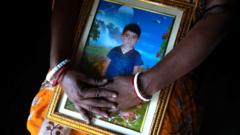One in three children drown daily in the Sundarbans, prompting local mothers to establish makeshift childcare facilities to prevent further tragedies and educate families on safety measures.
Mothers Unite to Combat Child Drowning Tragedies in India’s Sundarbans

Mothers Unite to Combat Child Drowning Tragedies in India’s Sundarbans
In the Sundarbans region of India, mothers are taking action against the rising rates of child drownings in wetlands by creating community-supported creches.
In the vulnerable landscape of India’s Sundarbans, where water is both a lifeblood and a lurking danger, motherly instincts have sparked a movement to safeguard young lives from the severe risk of drowning. Each day, the harsh reality is that three children lose their lives, with many cases occurring amid the region’s labyrinth of ponds and waterways.
Mangala Pradhan, haunted by the tragic drowning of her one-year-old son 16 years ago, now helps lead a group of local mothers who have mobilized to create makeshift crèches. These communal centers, established by the Child In Need Institute (CINI), provide needed supervision and care for around 40 children while their parents attend to daily work. "These mothers are the saviors of children who are not their own," states Sujoy Roy from CINI as he outlines the importance of these initiatives.
The circumstances that led to this movement are dire and shocking. A survey from 2020 revealed that nearly three children aged one to nine drown daily in the Sundarbans. Most incidents occur when caregivers are busy with household chores and children go unsupervised near water sources. The arriving monsoon season generally exacerbates this crisis, with floods making situations increasingly perilous.
Sujata Das, another grieving mother whose life changed after losing her 18-month-old daughter to drowning, similarly advocates for protective measures. She emphasizes the need for bamboo fences and nets around vulnerable ponds, as well as community CPR training for rescuers. The urgency is palpable; anecdotal evidence suggests that many drownings occur close to home, and local healthcare resources are insufficient for immediate response.
Yet, community resistance rooted in superstition remains a significant hurdle. Many villagers are hesitant to build barriers around ponds due to a belief that this may anger local water deities. In a neighboring region of Bangladesh, however, the implementation of wooden playpens saw drowning rates plummet after widespread education and community involvement.
The devastating statistics on drowning continue across the globe. The World Health Organization estimates that drowning claimed around 300,000 lives in 2021, with many victims being young children. While India officially documented around 38,000 drowning deaths in 2022, the actual toll is likely far greater.
Tragically, the Sundarbans is home to not only drowning hazards but also risks from local wildlife. Residents live in constant danger not only from the rising waters but also from tigers and snakes, which can threaten their livelihoods and safety.
As Mangala and other mothers step forward to protect the future of their community, they hope their efforts will shift the narrative around water safety. The impromptu crèches offer a program where children can learn to swim and understand the dangers of wandering off alone, with an optimistic note resonating from the small bodies of water. A four-year-old child was recently heard singing a reminder to his peers, reinforcing the importance of safety: “I won't go to the pond alone/Unless my parents are with me/I'll learn to swim and stay afloat.”
The mothers of Sundarbans are not only attempting to save their children but are also fostering a newfound spirit of solidarity, education, and safety that may well redefine their community’s relationship with water in the coming years.





















